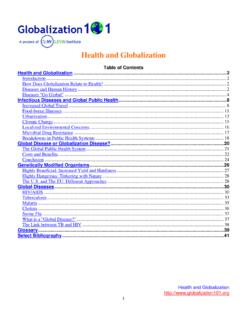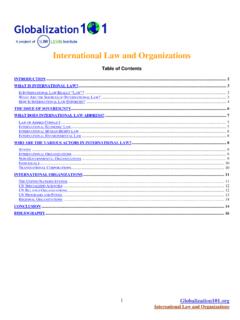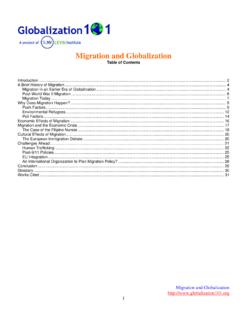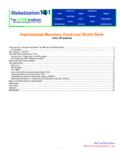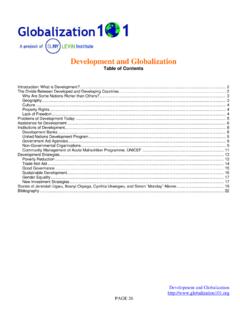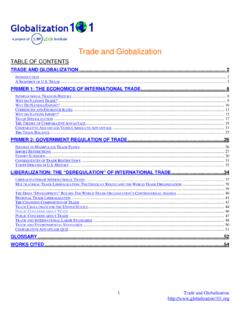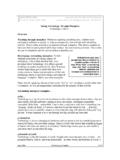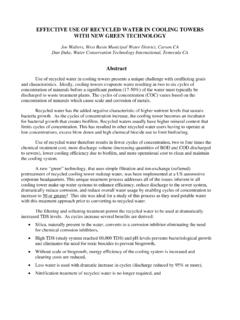Transcription of Technology and Globalization
1 Technology and Globalization 1 Technology and Globalization Table of Contents Technology and Globalization .. 2 Introduction .. 2 The Impact of Information Technology .. 5 Industrial Structure and Jobs .. 5 Workforce .. 7 Financial 7 Benefits .. 8 Short-Term Capital Concerns .. 9 Improving Sectors of Society: Health, Education, Journalism, and 12 Health Care .. 12 Education .. 13 Journalism and Media .. 15 18 Technology in Warfare .. 19 WWI & WWII .. 19 Weapons of Mass Destruction .. 20 Modern Warfare .. 21 Web 24 Social Networking Sites.
2 24 Peer Production: A Mighty Fortress of Collective Creativity .. 28 Open Source .. 29 Concerns of the Technological Age .. 32 The International Digital Divide .. 34 Privacy and Security Concerns .. 36 Conclusion .. 37 Ellie Walton and Sunju Ahmadu, young filmmakers .. 38 Glossary Of Terms .. 40 Bibliography .. 42 Technology and Globalization 2 Technology and Globalization Introduction In nearly every corner of the world, from Mumbai to Madrid, one cannot enter a caf or walk down the street without seeing someone talking, texting, or surfing the Internet on their cell phones, laptops or tablet PC.
3 Information Technology (IT) has become ubiquitous and is changing every aspect of how people live their lives. Recent advances in our ability to communicate and process information in digital form a series of developments sometimes described as an "IT revolution" are reshaping the economies and societies of many countries around the world. Picture Source: Technology IT is a driving factor in the process of Globalization . Improvements in the early 1990s in computer hardware, software, and telecommunications greatly increased people s ability to access information and economic potential.
4 While advancements in Internet-based tools over the past five to ten years, such as social networking websites, twitter, and other applications are changing the way people use and share information for personal, political, and commercial purposes. These developments have facilitated efficiency gains in all sectors of the economy. IT drives the innovative use of resources to promote new products and ideas across nations and cultures, regardless of geographic location. Creating efficient and effective channels to exchange information, IT has been the catalyst for global integration.
5 Products based upon, or enhanced by, information Technology are used in nearly every aspect of life in contemporary industrial societies. The spread of IT and its applications has been extraordinarily rapid. Just 30 years ago, for example, the use of desktop personal computers was still limited to a fairly small number of technologically advanced people. The overwhelming majority of people still produced documents with typewriters, which permitted no manipulation of text and offered no storage. Twenty years ago, large and bulky mobile telephones were carried only by a small number of users in just a few cities.
6 According to a 2013 International Telecoms Union (ITU) World Report, there were billion cell phone subscriptions worldwide at the end of 2012. Global mobile cellular penetration reached 96 percent in 2012 (ICT Facts and Figures, 2013). In some developing countries, mobile phones are used by more people than the fixed line telephone network. But perhaps most dramatically, just fifteen years ago, only scientists were using (or had even heard about) the Internet; the World Wide Web was not up and running, and the browsers that help users navigate the Web had not even been invented yet.
7 Today, of course, the Internet and the Web have transformed commerce, creating entirely new ways for retailers and their customers to make transactions, for businesses to manage the flow of production inputs and market products, and for job seekers and job recruiters to find one another. According to ITU World Report 2013, the total amount of users reached more than billion (39 percent of the world s population) by 2013. The news industry was dramatically transformed by the emergence of numerous Internet-enabled news-gathering and dissemination outlets.
8 Websites, blogs, instant messaging systems, e-mail, social networking websites, and other Internet- Technology and Globalization 3 based communication systems have made it much easier for people with common interests to connect, exchange information, and collaborate with each other. Education at all levels is continually transforming thanks to innovations in communication, education, and presentation software. Websites now serve as a primary source of information and analysis for the masses. Globalization accelerates the change of Technology .
9 Every day it seems that a new technological innovation is being created. The pace of change occurs so rapidly many people are always playing catch up, trying to purchase or update their new devices. Technology is now the forefront of the modern world creating new jobs, innovations, and networking sites to allow individuals to connect globally. The timeline below shows the rapid transformation of how Technology has accelerated within the last 20 years to 2012. 18 years ago: Internet commercialized 17 years ago: first mobile phone with Internet connectivity 15 years ago: Google named the search engine of choice by PC magazine 12 years ago: Blackberry launched 9 years ago: Facebook launched 7 years ago: Twitter launched 6 years ago: iPhone, the first of the smart phones, introduced 5 years ago: Groupon introduced 3 years ago: 17 million smart tablets sold estimated that 100 + million by 2014 1 year ago.
10 Google Glass announced Every 60 seconds (so it seems): new apps, tailored to users specific needs created Advances in Information Technology The IT revolution drives the extraordinarily rapid decline in the cost and rapid increase in the processing power of digital technologies. The digital device whose technological advance has perhaps been most crucial to the IT revolution is the microprocessor, the collections of millions of tiny circuits that serve as the "brains" of personal computers and that are embedded in an ever-expanding number of products, from video games, to cars, to refrigerators.
